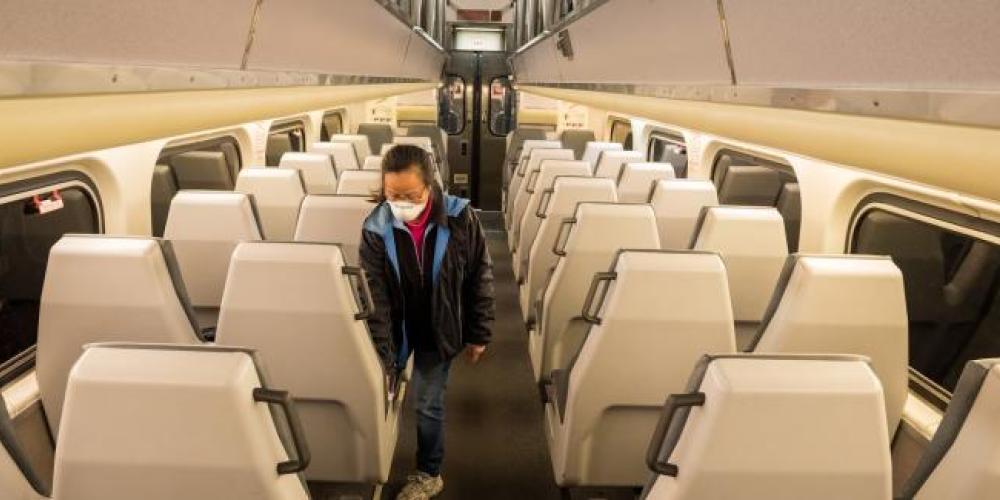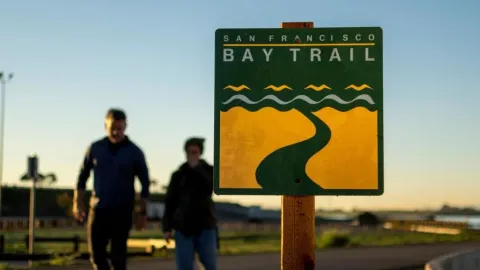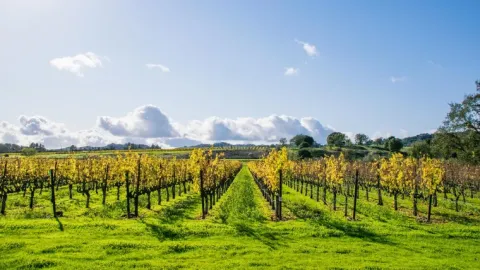
We, like the slime mold ...
I’m a full-time freelance photographer with a love of science and an odd obsession with slime mold, a 600 million-year-old, often overlooked, misunderstood and mischaracterized single-celled organism that undulates across rotting foliage in damp forests. For the last two years, I have wanted to create a time-lapse photo sequence of slime mold in a Petri dish as it forages, navigates obstacles and thrives despite challenges.
Slime mold in Karl Nielsen’s backyard garden. Credit: Karl Nielsen 2013 iPhone Instagram Pic.
Sadly, I had not found the time to do this but with the emergence of the COVID-19 pandemic, I realize I do not need a Petri dish and a macro lens to observe organisms contending with restricted movement, localized resources and unknown challenges.
I just can watch how our daily transit use has changed and humans’ transportation priorities have shifted.
Slime molds are blobs with multiple nuclei formed when single flagellated cells swarm and fuse. They can change shape, stretching and shrinking, as they eat. Sections of the sprawling organism can transfer resources as needed to other sections through pulsating channels. Sprawling edges that find no resources will retreat and leave chemical messages about what they found or did not find in the area that they explored. Through this process, the organism can create intricate and highly efficient supply chains, move through complex spaces and even learn from past experiences.
Sound familiar?
I’m sure it does, because just like a simple slime mold living on the forest floor, humans have to overcome basic challenges such as transferring resources from one section of our inter-connected communities to others.
As the COVID-19 virus has begun to impact I’ve been watching our supply chains change and our communities communicate their needs much like the slime mold would. Instead of using a macro lens to document the movements of a protist in a Petri dish, I’m using a drone, and wide-angle and telephoto lenses as the COVID-19 pandemic evolves to document the activities of Homo Sapiens living around a bay on the west coast of a northern landmass on a little blue planet.
I’m keeping an eye out for both the emotional human story and the clinical scientific story. I’m looking for images that show solid evidence of how this global event has affected us -- images that can be viewed 100 years from now and that convey the impact COVID-19 has had on our community.
But, as definitive proof isn’t always enough to sway hearts and change minds, I will also be looking for images that tell compelling personal stories.
I went out Monday, March 16, after Gov. Gavin Newsom ordered bars to close and those 65 and over to self-isolate, looking for images of change within our community. To be honest, I didn’t find many. The daily commute looked mostly the same; people were out and about and people were taking few, if any, precautions to avoid spreading the contagion.
Maurice Coxeff, practices skateboarding at the El Cerrito BART Station, 3/16/2020.
I-80 Commute as seen from the Berkeley Pedestrian Bridge 3/16/2020.
Toll worker handles cash and receipts without gloves. 3/16/2020.
Just 24 hours later however, after Bay Area health officials announced shelter-in-place orders, the scene changed dramatically. When I went out this time, the commute traffic looked entirely different, and people's behaviors and concerns were noticeably changed. People were obviously avoiding touching handrails and door handles and obsessively washing bus and train seats before sitting down.
CalTrain passenger disinfects her seat before sitting in it. 3/17/2020.
MacArthur Maze, in Oakland 3/17/19 at 10 a.m.
Richmond Costco Parking Lot 3/16/2020, 5:30 p.m.
Richmond Costco Parking Lot 3/17/2020, 5:30 p.m.
While I have yet to create my slime mold time-lapse, I know how the sequence will go.
It will start with the slime mold at the center of the frame with food and water on either side. The slime mold will create tentacles that will reach out for the two basic resources it needs to grow and thrive. At some point, I will introduce some obstacles, maybe even a minor poison, like salt, and the slime mold will readjust its pathways and learn from its encounters.
If we, like slime mold, are to overcome the challenges posed by the COVID-19 virus, we will establish pathways that we need. We will readjust and stretch a bit as resources change. We will learn from our experiences and continue to travel throughout the Bay Area through modified pathways not unlike how slime mold undulates across the forest floor.
More photos can be found here: https://www.thecaliforniastory.com/f170870517.



Submit your comment
In order to receive a reply to your comment, please provide an email address.